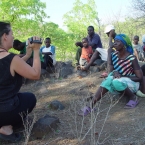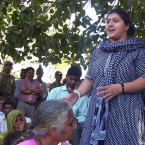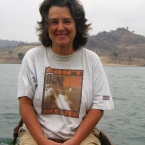Our Rivers, Our Lives
The movement to protect rivers and rights is full of amazing women. We asked just a few of them to talk about the rivers they love, and what they hope for their future.
Our River is Our Name
Caleen Sisk-Franco, Tribal Chief and Spiritual Leader, Winnemem Wintu Tribe, (California, U.S.A)
The name of my tribe, Winnemem Wintu, translates to Middle Water people and is taken from the name of our river, the Winnemem Waywakit, which is bounded by the Upper Sacramento to the West and the Pit River to the East.
Now known to most as the McCloud River, it rises from glacial waters in the Cascades, and it runs so clean you can clearly see the rocks, sand and insects that populate its bottom. A series of well-known waterfalls cascade over its basaltic lava beds in feathery ribbons of white and foam.
Because of its beauty, most people here in Northern California probably believe the McCloud is healthy and pristine. But that is only because they don't remember, as my tribe does, how it used to be before it was butchered by dams and left clinging to its life.
The Shasta Dam was built during World War II and flooded the lower 26 miles of our river under its reservoir. It also blocked our sacred relative, the salmon, from traveling to its traditional spawning places. In 1965, the McCloud Dam was built on the upper river and started diverting water to the Pit as part of a lucrative hydroelectric project. Because of these diversions, our once powerful and rushing river, which once had a winter flow of 6,000 cubic feet per second, now trickles at a mere 200 cfs.
Our river is starved on one side and swollen on the other. And yet they are not done with it. As we fight to bring our salmon back, we also fight against a proposal to raise the Shasta Dam as well as a McCloud Dam relicensing that could sustain the crippling diversions for another 50 years.
Just as they have carved up our river, so too have they tried to break our bond with it by extricating us from our traditional lands and refusing to acknowledge our history and right to exist. But they underestimate our resilience: our spiritual connection to our river remains strong and unbroken.
Our river is our name. And we are willing to die to defend it.
Homage to Colombia's Sogamoso River
Consuelo Acevedo (Colombia)
I woke up and felt my body wet, floating in the river, gently rocked by the water and listening to a dream induced like music born of her womb. Time does not exist, not even the certainty of existence. Here everything is diluted.
I've been wondering, how will the river change when they build the Hydrosogamoso Dam? I've heard that they are calling the great mass of cement that will divide up the river "La Tora," which in the language of the Yariguí Indians means "place overlooking the river." It's a mistake to call it that way, because they are destroying this place. That is the way of the cynics who have the money. They take the language of our ancestors to confuse us. To fill us with doubts.
Everything will change. Neither the papayas, the lemons, the avocados or bananas will grow in this fertile valley ever again; it will be under water. Even the cattle grazing in the pastures are being forcibly evicted. What will happen to the manatee that live in the wetlands of the lower river? They are already predicting the decline of the wetland, as it were a natural process; they are not complying with the Ramsar Convention agreements which are agreements to protect these rich ecosystems, and which the Colombian government ratified. We already know what is going to be the future for a great number of families, they will be statistics of the poor in the cities.
Suddenly the wind ceased. I don't know if I am in my mother's womb or in the riverbed. It is easily confused, the two areas are different yet the same.
The Rivers Will Rise Again
Liane Greeff (South Africa)
The earliest river I remember was the nameless one across the road from our house where I grew up - just a small stream flowing through the leafy suburb ironically named Bergvliet, which means mountain stream. One day they came with bulldozers and concrete pipes, and when we woke the next day, the river was gone, completely gone. Similarly, my sisters used to visit the wetland around the corner from our house to sneak a cigarette until that too was concreted over and became the M3 - the main motorway from the Southern Suburbs into the center of Cape Town. Neither the people who live in my old street or the majority of those who commute daily to the city center have any idea of the stream and the wetland that have disappeared in the name of development and urbanization.
Not knowing what is lost is part of the tragedy of rivers for me - that they are destroyed or compromised and the new people don't even know what once was. So much of our planet shares this fate, but the rivers are a special symbol of both the flow and the web of life, which we as a species are destroying river by river, and most of us have no idea what has gone. I am strengthened, however, by my belief that despite the destruction, the rivers are strong and will return in time, and all that humanity does is temporary.
My vision for rivers in the 21st century is to safeguard and celebrate our remaining rivers, restore degraded rivers, and raise awareness of the valuable contribution rivers make to life on Earth. Through my organization EcoDoc Africa, which I started with my partner Roy MacGregor, we aim to achieve this by producing documentary videos and photographic essays, and work in solidarity with river activists throughout Africa and around the world who stand united behind the cry "Rivers for life, not for death! Agua para la vida, no para la muerte!"
Love at First Sight
Dipti Bhatnagar (India)
The Narmada Bachao Andolan (NBA, or Movement to Save the Narmada River), recently commemorated 25 years of constant struggle against the Sardar Sarovar Dam project and other large dams that threaten to turn a vibrant river valley into nothing but a series of reservoirs. This one dam, which is still under construction, is slated to directly submerge the hearths, homes and farms of almost 100,000 people, including thousands of indigenous people of central India. This movement has shaken up behemoths such as the World Bank and the Indian government, helped insert the voices of the most marginalized people into water policy decision-making in India, and continues to speak truth to power.
Today, thousands of homes and lands are already under water from this dam, and the people that lost everything are still waiting on higher ground for justice, for fair and dignified rehabilitation. However, hundreds of thousands more homes and lands and thickly populated villages have been spared the horrors of flooding and displacement. The only reasonable step forward is to permanently stop the dam at its current height, and provide rehabilitation to all affected.
Large dams have come under immense criticism worldwide in the last two decades. Yet the dam industry continues to spread its tentacles of outdated dangerous technology, today under a new guise of providing "clean hydropower energy" in a changing climate. The ongoing Narmada struggle against impending submergence is a constant reminder to me of the importance to continue the fight against dams, and to protect rivers.
The Zambezi River: My Inspiration
Anabel Lemos, (Zambia)
The Zambezi River is the fourth largest in Africa and the largest system flowing into
the Indian Ocean. Born in Zambia, its crosses Angola, Namibia, Bostwana, back to Zambia, then Zimbabwe and finally flows through the heart of Mozambique, pumping life into one of the most diverse and important ecosystems in Africa.
The first time I saw the Zambezi, I fell in love with this marvelous river and its people. A night on the river is unforgettable, the peacefulness of the night with a sky full of stars, the water flowing, the sound of hippos and of drums in the distance - it is one of the most wonderful and magical experiences. The more time you spend along the Zambezi the more you understand its beauty. Seeing the way traditional habits harmonize with natural patterns, how floods link up with with floodplain farming, the way wildlife migration patterns and mating timed themselves to seasonal changes of the river. A beautiful coexistence has been achieved through millions of years of coevolution.
But as with many things in Africa, great beauty is often mixed with abuse and suffering. In the case of the Zambezi, large dam such as the Kariba and Cahora Bassa have been at the heart of this abuse and suffering. The dams have artificially regulated the river, killing the seasonal patterns responsible for so many natural and social functions. Now wetlands no longer receive fresh flood water as often. Seawater is creeping inland, making farming impossible in once-fertile areas. Subsistence farmers lose their food crops from unexpected dam releases. The dams have turned floods from a blessing into a curse. And all this to produce energy for export while less than 14% of Mozambique's population has access to electricity.
Now the Mozambique government wants to build another mega-dam, Mphanda Nkuwa, which will only worsen these existing problems.
I have a dream that one day the Zambezi River will be free from the impacts of dams - that it will once again support millions of people and the biodiversity that has made the Zambezi so special. I have been fighting for this for a decade and will continue to flight till my end. I cannot accept the greed, corruption and lack of insight that threaten this ecosystem that brings so much good to so many. The need for energy cannot supersede the right of the people along the Zambezi to live. The past has shown that the consequences of dams can be a life or death matter for many. Rivers are life!
Dams Equal Death
Larissa Elena Duarte (Panama)
The Rio Cobre is our earthly paradise, our joy, our pride, our support, our identity and especially our home. The river does not belong to the community, we belong to it.
That is why when we learned that they want to dam it to produce electricity, which is not for the benefit of our communities but for the profit of private businesses, we get angry. We will fight so they don't deal with the river as a commodity.
It has been almost 8 years since rural women, with their
We feel responsible for not quitting this fight, we feel guardians of the Rio Cobre. There is a spiritual connection between the mind and the heard that push us to continue this fight despite adversity. Every time we see the little ones bathing, fishing and enjoying the water in the river, our hearts and minds again are filled with new energy and hope.
Rivers are living beings that have a voice, but not all learn to listen and understand it.
It is our responsibility as guardians of the river, to raise its voice and made it understood by all. The source of life transmitted by rivers has to be preserved, today and tomorrow, always. It does not matter if we loose because we maintain the flame of resistance to defend life. We should not be afraid of repression, to the indifference of people and the loneliness of the struggle. We build the future with the actions we take on now, and fear is not our ally, it is our enemy. Solidarity and conviction in our ideas are our best allies. The brave never give up, they move forward.






